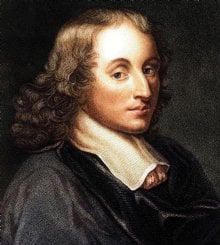Overview
Composed in 1654 and printed posthumously in 1665, Blaise Pascal’s Traité du triangle arithmétique codifies the structure and uses of the arithmetical triangle now bearing his name. The treatise introduces a systematic array of numbers generated by a simple additive rule and then develops a network of consequences touching combinations, binomial expansions, figurate numbers, summation identities, and the emerging calculus of probability. Across concise propositions and corollaries, Pascal presents the triangle as a universal engine for discrete calculation and reasoning.
Constructing the Triangle
The triangle begins with 1 at the apex; each interior entry equals the sum of the two entries immediately above it. Boundary entries are 1s, producing rows that start and end with unity. This rule yields a symmetrical, infinitely extendable table. Pascal proves the basic recurrence, the symmetry of each row, and the pattern of row sums doubling at each step, so that the nth row totals 2^n. He treats the triangle not as a curiosity but as a generative device whose internal law produces an organized universe of number relations.
Combinations and the Binomial Theorem
Interpreting each entry as the number of combinations of n objects taken k at a time, Pascal shows that the triangle enumerates all possible selections without order. The defining recurrence becomes the combinatorial identity C(n, k) = C(n − 1, k − 1) + C(n − 1, k), reflecting the choice to include or exclude a marked element. From this basis he derives the coefficients that appear in expanding powers of a binomial, giving a clear algorithm to read the coefficients of (a + b)^n from the nth row. He further draws consequences for algebraic summations, including identities obtained by summing along rows or along slanting diagonals, and highlights how the triangle unifies enumeration and algebra.
Figurate Numbers and Diagonal Sums
Pascal links the triangle to figurate numbers, triangular, square, pentagonal, and higher polygonal numbers, and to tetrahedral and pyramidal numbers in three dimensions. He shows that diagonal accumulations in the triangle yield these sequences, giving a compact method for deriving and summing them. The so‑called “hockey‑stick” pattern appears as a principle for summing successive entries along a diagonal to obtain a deeper entry, revealing nested structures of accumulation. These geometric interpretations translate combinatorial addition into arithmetic formulas for classic sequences.
Probability and the Problem of Points
A striking application addresses the fair division of stakes when a game of chance is interrupted, the celebrated problem of points. Pascal deploys the triangle’s coefficients to count the number of possible future sequences of wins and losses and to apportion the stakes proportionally to favorable outcomes. This combinatorial approach, developed in dialogue with Fermat, anchors an early theory of probability by replacing vague expectation with precise enumeration. The triangle thus serves as a computational scaffold for equitable decision‑making under uncertainty.
Method and Legacy
Throughout, Pascal advances a method of proof grounded in recurrence and orderly arrangement, prefiguring later forms of mathematical induction. The treatise demonstrates how a single elementary rule, iterated in a table, radiates into algebra, geometry of numbers, and probability. By articulating the triangle’s properties and practical uses with unusual clarity, Pascal furnishes a compact calculus for discrete structures. The work became a cornerstone for combinatorics and probability, and its patterns, row sums, symmetry, binomial coefficients, and diagonal summations, remain foundational tools in mathematics.
Traité du triangle arithmétique
Traité du triangle arithmétique is a treatise in which Pascal introduced his so-called 'Pascal's Triangle,' a triangular array of the binomial coefficients.
Author: Blaise Pascal
 Blaise Pascal's life, his innovations in math and science, and his impact on philosophy and literature.
Blaise Pascal's life, his innovations in math and science, and his impact on philosophy and literature.
More about Blaise Pascal
 Blaise Pascal's life, his innovations in math and science, and his impact on philosophy and literature.
Blaise Pascal's life, his innovations in math and science, and his impact on philosophy and literature.